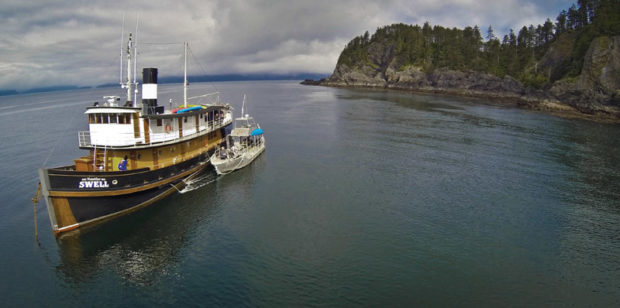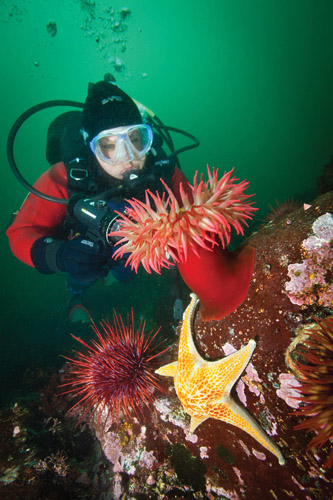Dive Traveller: Haida Gwaii
The dive live-aboard Nautilus Swell travels back in time to an archipelago and culture thousands of years old
Text and Photography by Dale Sanders

Haida Gwaii is a remote and windswept archipelago more than 60 miles (100km) off the north coast of British Columbia, inhabited by the Haida since, well, forever. Then English explorers showed up in 1778 and, as they were inclined, named the place, in this case for the wife of their monarch. So they became the Queen Charlotte Islands. For their unique and diverse ecosystem they’ve also become known as Canada’s Galapagos. But to the indigenous people who’ve inhabited this mystical rain forest for thousands of years, they are simply the ‘Islands of the Haida People’, that is, Haida Gwaii.
It’s a magical place that seems to transport you back in time. If you don’t find yourself there soon enough, a visit to the ancient village, and cedar totems, of SGang Gwaay will do the trick. It’s a haunting experience standing before these weathered totems, their sightless eyes forever fixed on the sea. Little wonder this Anthony Island treasure is nurtured in Gwaii Haanas National Park Reserve, and is a National Historic Site of Canada as well as a UNESCO World Heritage Site.
Diving in Style
It’s just after dawn as I slip into the empty lounge of Nautilus Swell for a steaming mug of coffee, then quietly move outside and forward to the bow. The java helps lift the early morning fog in my head as I peer across the still water at jagged reefs that skirt the islets all around. It’s a scene you might see elsewhere on the BC coast, but here in the land of the Haida it’s easy to imagine hand-hued war canoes slicing through the early morning calm. My reverie replays an old black and white film clip screened for years at the Royal British Columbia Museum in Victoria. It’s from the 1914 Edward Curtis film, Land of the War Canoes, focused on the Kwakwaka’wakw (Kwakiutl) people of the central coast, not the Haida, but the images are indelible. The canoes approach, masked spirit figures of bear and eagle dance at the bow, paddles drumming cedar, it’s mesmerizing and it’s playing over and again in my head.
I hear sounds and realize there’s some movement aft. Moving to the stern I find some of my shipmates preparing for an early morning exploratory dive so I quickly slip into my drysuit and join them aboard our spacious 38-foot (11.5m) dive skiff Inde. Diving doesn’t get much easier than this: my gear is already set up and waiting, a full tank of Nitrox my ticket to the show.

In minutes we’re at our dive site, leafy kelp forests, colourful anemones and schools of rockfish almost still in the gentle drift. Lazily, I fin past a wall of white and orange plumose anemones. In this neon circus of a place even the gaudy, like the Red Irish Lord, blends in. A giant pacific octopus is not quite invisible for the pile of discarded crab shells that give it away. Hidden in dark shadows near the back of a small undersea cave I spot a strange elongated fish that I’ve never seen before, and photograph, later to ID as an Alaskan Ronquil. Northern BC is the southernmost edge of its range and for me it’s a kick to observe a new species after more than 30 years of exploring all the nooks and crannies of this convoluted coast.
It’s a lush marine world we’re enjoying in Haida Gwaii. As the sun ricochets through the kelp canopy I see that along with the usual Bull kelp there are some dense undersea groves of Northern Giant kelp, a slightly smaller version of the giant kelp found off California. Here and there we see also a few small patches of Red Soft Coral. It’s tantalizing to think that somewhere in this sprawling marine archipelago there may be a hidden pass loaded with the stuff, a place to rival the legendary soft coral of Browning Wall at the top end of Vancouver Island.
It’s springtime in the Pacific Northwest and the sunshine has blown the plankton into full bloom making our visibility a variable commodity ranging from 10 to 30 feet (3-9m), depending on the dive site. But we couldn’t care less. It’s the plankton that fuels the abundance of life we see at every turn. Ever since my first and never forgotten visit to Haida Gwaii years ago I’d been itching to return and now, aboard Nautilus Swell, I’m back and I’ve got a ringside seat.
As we ascend from our first dive we transit surge-swept shallows where blue mussels are hungrily helping themselves to the microscopic cereal of the sea, and then we’re done, our heads pop up and our dive skiff appears with plenty of helping hands to pluck us from the water. Back on deck we’re greeted by the never wavering smile of our hostess Tiare who plies us with favorite hot drinks and goodies to warm body and soul.
Gwaii Haanas National Park
We’re cruising and diving the rich waters of Gwaii Haanas National Park Reserve, a vast protected area that takes in the entire southern half of Moresby Island – 1,300 square miles/3,400 square kilometers – as well as the hundreds of surrounding smaller islands, islets and rocky reefs. The park’s name means ‘Islands of Beauty’. First protected in 1988 after years of anti-logging protest and land negotiations, it was declared official in 1993. Today, the park is managed by Parks Canada and the Haida people in a unique partnership. Gwaii Haanas National Park Reserve, National Marine Conservation Area Reserve and Haida Heritage Site, comprise some 1,950 square miles (5,000 square kilometers) of land and ocean.
The Nautilus Swell is the first live-aboard dive boat to ply these waters in nearly 20 years so this is truly adventure diving at its finest. Each day offers the real chance of diving a site where no one has set fin before. And with each visit the Nautilus Swell adds to its growing list of charted sites. The diving will only get better!

And when we weren’t diving we explored a number of Haida Heritage Sites scattered across the archipelago, guided by our own onboard licensed Gwaii Haanas interpreter and naturalist Laura Pattinson, and by the Haida Gwaii Watchmen, who live and work at the sites May through September. At the abandoned village of Skedans or K’uuna Llnagaay on Louise Island, once home to several longhouses, we watched blacktail deer feeding among the remaining mortuary and memorial totem poles on the site. Our guides provided fascinating insight to the history and culture of the islands and the Haida people. This dive trip was unlike any other.
At Rose Harbour we explored a long abandoned whaling station. Nearby, on a few scattered parcels of privately owned land, hardy homesteaders still live and thrive. On the beach you can see some rusting bone digester tanks and there’s a disintegrating furnace building too. Off this west coast of Haida Gwaii the ocean bottom angles deeply into the sea, providing little or no continental shelf. Upwellings of cold, nutrient rich water here have long attracted whale populations that were decimated by the global whaling industry before the Government of Canada put a stop to the practice in its territorial waters.
Nearly 40 years later whales are making a comeback. The day after our visit to the whaling station we were thrilled to see humpback whales cavorting nearby as the Nautilus Swell steamed slowly northwards through windy Hecate Strait. Even Sperm Whales have been sighted from time to time off the west coast of the island and perhaps most exciting of all was news reported only weeks after our visit of the first confirmed sighting of a Pacific Right Whale in British Columbia. It was the first seen in over 60 years!
Another memorable dive during our time at Haida Gwaii was at Inner Low Rock in the Copper Island Group. There, we were treated to endless sloping walls blanketed in stubby short white and orange plumose anemones. It seemed like we could glide over them forever. Grunt sculpins and decorated warbonnets were among countless fish and other critters that made their home in this carpet of life. Steller sea lions often haul out on the rocks here but were preoccupied when we came through. We didn’t see any above or below the water on that occasion but there’s so much to see if you have a keen eye, such as the Moss Head Warbonnet whose tiny head I spied staring out at me from its nook in the rock.
At the end of this dive we tuck into the shelter of a small submarine canyon to do our safety stop and the surge almost sweeps me onto a large, well-camouflaged Cabezon hidden on the reef. I’m not sure who’s more surprised, but in a sudden reactive moment it disappears into the depths. There’s so much to see that you don’t see! On final ascent I glimpse a strange-looking but familiar stare in the kelp jungle, it’s that lovable muppet-faced wolf eel hanging out in just 10 feet (3m) of water.

We’re loving the relaxed atmosphere on this trip and later we pass on beach hike at our anchorage in favour of lounging in the hot tub on the back deck. Our warm soak recalls a nearby hot spring, a favourite visit on these trips until a 7.8 magnitude earthquake shook the region in late 2012, and turned off the tap. Since then hot water has started flowing from nearby cracks in the rocks offering hope that the hot springs pools may eventually refill. In the meantime Nautilus Swell’s hot tub is a fine substitute.
Meals aboard Nautilus Swell are superb. Chef Benoit’s creations are a highlight of each day, and that’s saying a lot considering the pristine diving on offer in Haida Gwaii. On one occasion we were in mid meal when a shot had us all running for the back deck where we watched a black bear ambling slowly along the very beach that some of our group had left minutes before. The quiet here is complete and at day’s end you can retire to a comfortable stateroom and drift off in no time, with those ancient totems in mind, perhaps. Haida Gwaii is a timeless place where for a fleeting time we revel being off the grid in a land seemingly forgotten.
For more information visit http://www.nautilusswell.com/







